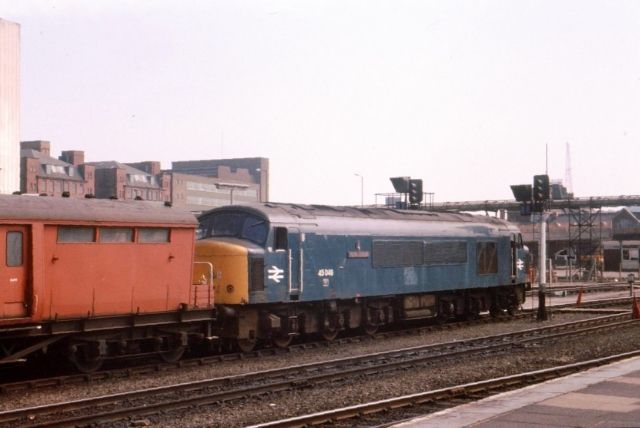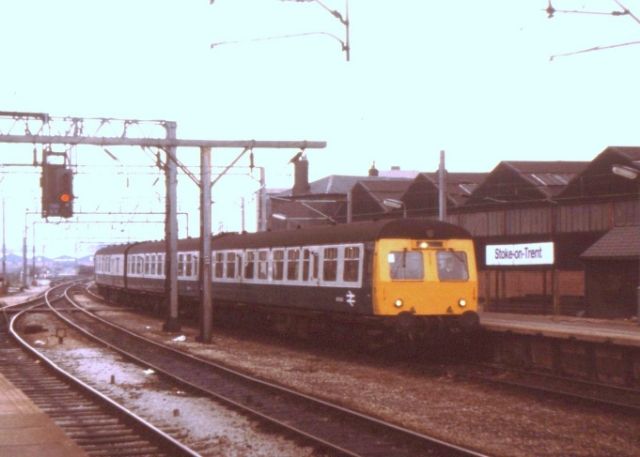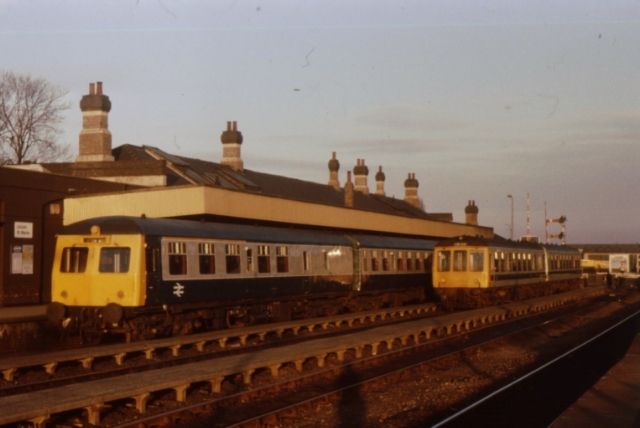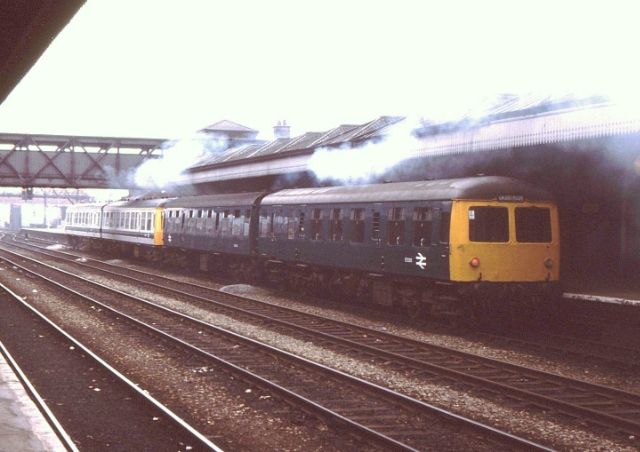-
Content Count
1,815 -
Joined
-
Last visited
-
Days Won
2
Content Type
Profiles
Forums
Calendar
Posts posted by Merthyr Imp
-
-
That looks good.
-
#47: The loco in the scenes was a clas 37 Co-Co Diesle electric locomotive. The one in the real robbery was a class 40 1Co-Co1 diesel electric. [as Rob237 would no doubt have told us]

Yes, I suppose a 37 was near enough. They at least took the trouble to give it the number of the actual engine - D326.
But a slip was to show a photo of the loco on the wall of the police investigation office marked 'Class 40 diesel locomotive'. They weren't known as class 40s back in 1963, as that system of class numbers only came in later on. 'English Electric Type 4s' we spotters used to call them - or else D200ers.
-
 1
1
-
-
Not forgetting Nottingham Omnibus around late eighties.
Did anyone ever travel on one of them? They always seemed to be running around empty when I saw them.
-
Did anybody watch the Great Train Robbery on BBC?
Just watched it back to back on catch-up compelling viewing thoroughly recommended.
Yes.
I thought it was quite fair in the portrayal of the treatment of the driver, Jack Mills. I also liked the Chief Superintendent referring to the gang as 'cowards with coshes'.
The railway sequences were ludicrous though, with the single track Keighley & Worth Valley Railway (with the Yorkshire moors visible in the background) masquerading as the four-track main line to Glasgow through flattest Buckinghamshire. Other sloppy errors were too numerous to mention showing a lack of research.
-
Didn't a film on video originally cost around £30 - £40?
-
-
Probably the biggest star I ever saw at the Theatre Royal - some time in the 1980s, I think it was, in Shaw's 'Man and Superman'. Wasn't keen on the play (too much of people just sitting around talking), but it was a privilege to have seen him.
-
Yes, they were great. They arrived unannounced (as far as the public were concerned) in October 1968. I went to work, Sawley Junction to Derby, on a Cravens in the morning, and came back home the same evening on a Swindon 120. Their big problem was that they were heavily insulated with blue asbestos (they were not unique in this however).
Here's another one. Taken at Stoke around the same period.
-
When I was carriage cleaning in the late 70s I preferred the 3-car Swindon sets.
As seen on the left here? Photo taken probably around 1980 at Lincoln St Marks station (now the site of a shopping area, although the station building survives).
It looks as if the first class area - denoted by the yellow band above the windows - was still in use as such at that time, but it can't have been too much later that they downgraded it to be used by all passengers. With the 'two and one' seating and the deeper padded seats I always used to try and get in that area on my journeys back from Lincoln.
-
-
The engine named 'Springbok' was no. 61000 (I remember seeing it at Victoria Station in about 1961).
The photo is of an engine of the same class - a B1 - but I wouldn't said they were generally known as the Springbok class. In fact locomen would be more likely to call them 'Bongos' after no. 61005 which was named 'Bongo' (after a breed of antelope).
-
Dr Evadne is pretty good on the piano as well.
Yes, the performer (although not a Doctor of Music like the character) is an Academy-trained classical pianist and musician. The act was a remarkably talented pairing.
-
Not parents, but looking at the dismal, gloomy weather this morning I was reminded of something my grandmother use to say:
'It must be one o' them dark days afore Christmas'
-
Yes, they had a TV series and also a radio series at one time. I saw them once at the Theatre Royal and once at the Royal Concert Hall - I suppose both times it would have been between the late 1970s and late 1980s.
The double entendres were much naughtier in the stage shows than on TV or radio. But with the stage shows especially, I always felt you could enjoy them on two levels - for the comedy and parody, and also simply as a concert of Gilbert & Sullivan and old musical comedy songs - the Ivor Novello, Maid of the Mountains, No, No, Nanette, etc, type of thing. Because in amongst the parody the songs were well performed and could be taken at their face value. He/she ('Dame Hilda') had a remarkable voice.
-
Tizer i think they still make that i think it now comes under the Barrs label with Iron bru
Yes, it's made by Barrs now - you can buy multipacks of the cans in Tesco. It's not as red as it used to be - more like the colour of Lucozade.
If I remember right, Tizer used to be made by whichever company it was who made a brand of orangeade called Jusoda.
-
There's loads of information on the Internet that shows he was often dressed in red before the Coca Cola adverts began, and there are various examples to be found of illustrations from the 19th century showing him in red. But he was also as likely to be dressed in other colours.
There's something of a distinction as well between Santa Claus - in the tunic with the belt - and Father Christmas - in the robes. Father Christmas is always depicted in red these days, but I think it was the Santa Claus in the red TUNIC that Coca Cola featured.
The two names are more or less interchangeable, but when I was a child he was more often referred to as Father Christmas.
-
Top Cat, the cat food - which when it was introduced caused the BBC to rename the cartoon series of the same name Boss Cat so as not be seen as advertising it.
-
Yes fch, the original Survivors was one of the best TV programmes I have ever seen, great storyline.
Can't remember many of the cast only Lucy Fleming and the gorgeous Carolyn Seymour .
I actually liked Lucy Fleming better (daughter of Celia Johnson of 'Brief Encounter' fame).
There was probably a bit less action in the original Survivors than the recent version - all I remember is they used to do a lot of driving around in Land Rovers.
-
We used to have to do dancing when I was at Blue Bell Hill school in the 1959 - 61 period (for that matter we also did at the village school in Lincolnshire where I lived before that).
I can't really remember the names of the dances we did - was there one called the Circassian Circle? - but I know there were lots of reels, and whatever they were they usually involved linking arms with your partner and 'promenading' down between the lines of the others. We also did the waltz and the polka.
As I remember you always danced with the same partner - mine was named Helen - everyone was paired off! (This was at ages 9 to 11)
-
Which was the one with the walzy music and the cut out figures going round?
Tales of the Unexpected? The Roald Dahl series. I think it's available on DVD.
Thriller is available in a boxed DVD set, or was a few years ago.
-
Where's Tyafans to tell us it was all done by aliens from Mars?
-
There's a lot of discussion about the Scala/News & Cartoon Cinema in the 'Nottingham Demolition' thread.
-
That's marvellous - so many details of interest.
-
I don't know about Clifton Colliery, but according to the histories I've consulted Queen Victoria wasn't involved the opening of any of Nottingham's stations. The first station - more or less opposite to the present one (but not quite) - was opened in 1839, but not apparently by the Queen.
It's recorded in a couple of books, including 'Rail Centres: Nottingham' by Michael A. Vanns that the Queen visited Nottingham by train in 1843. Quote from that book: 'For the visit of Queen Victoria and the Prince Consort on 4th December 1843 a new road was built parallel to Station Street, south of the railway. This new road curved eastwards away from the station to join the Flood Road (London Road), and was appropriately christened Queen's Road in honour of the event.'
'Railways in and Around Nottingham' by V. Forster & W. Taylor refers to the same visit by the Queen in 1843: 'Queen Victoria, no less, travelled by train from Chesterfield to Nottingham en route to Belvoir Castle and after being received by the Lord Mayor and other worthies Her Majesty continued the journey by carriage along the new road which had been formed parallel to the line of railway but to the south east and which to this day is known as Queen's Road.'
The second Midland station, with its entrance on Station Street was opened in 1848 - no mention of the Queen being involved.
As for the present station, construction of it wasn't even begun until 1903, a couple of years after Victoria's death.
So perhaps she made a separate visit to open Clifton Colliery, resulting in Queen's Drive being named?







Things our parents used to say
in Nottingham Lingo
Posted
Isn't it ce rather than ca? Ce n'est fait rien - literally, 'it makes nothing'.
Well, it's a long while since I passed French O Level (thanks to 'Wassimodo' at High Pavement)!